Report on Leadership Styles and Organizational Objectives at Apple
VerifiedAdded on 2021/12/03
|18
|6337
|21
Report
AI Summary
This report provides an in-depth analysis of the leadership styles employed at Apple, focusing on their impact on team performance and the achievement of organizational objectives. It begins with an executive summary and an introduction that highlights Apple's commitment to innovation and its approach to product design. The report then explores the various leadership styles, including both transactional and transformational approaches, and assesses the prevailing styles within Apple. It examines the influence of Steve Jobs' leadership, characterizing it as a blend of both transformational and transactional styles. The report also discusses how Apple's leaders can foster a culture of expertise, mutual trust, and support. Furthermore, it considers Apple’s ethical and value-based approach to leadership, examines the influence of culture and ethics, and addresses stakeholder needs and expectations. The analysis includes references to relevant literature and concludes with recommendations for further enhancing leadership effectiveness within the organization.
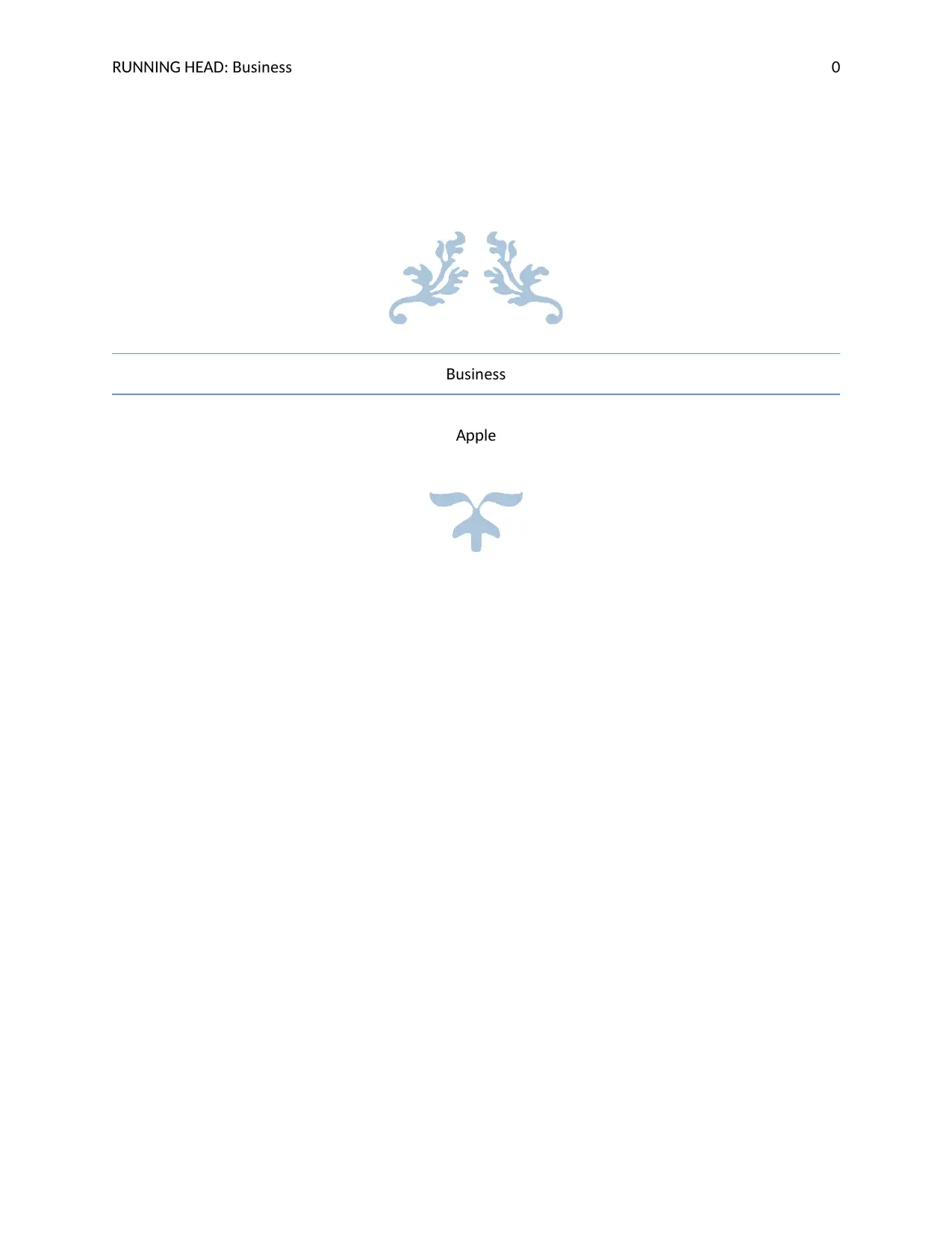
usinessRUNNING HEAD: B 0
usinessB
leApp
usinessB
leApp
Paraphrase This Document
Need a fresh take? Get an instant paraphrase of this document with our AI Paraphraser

usinessB 1
Executive summary
The business is the commercial activity. It is a system where goods and services are exchanged
for one other or for the money. This report includes the various leadership styles vital in the
situations faced by the Apple in accomplishing organizational objectives. Apple is an American
multinational technology company. It is having headquarter at California, US. The company was
established in 1976. The company has diverse collection of the thinkers and doers that
continuously reimagines the products and services so that people love in the new ways.
At the end, it can be concluded that prevailing leadership styles in the Apple can stimulate the
team’s performance and organizational objectives. The leaders can also establish a culture of the
professionalism can develop the team’s understanding of the organization’s direction.
Executive summary
The business is the commercial activity. It is a system where goods and services are exchanged
for one other or for the money. This report includes the various leadership styles vital in the
situations faced by the Apple in accomplishing organizational objectives. Apple is an American
multinational technology company. It is having headquarter at California, US. The company was
established in 1976. The company has diverse collection of the thinkers and doers that
continuously reimagines the products and services so that people love in the new ways.
At the end, it can be concluded that prevailing leadership styles in the Apple can stimulate the
team’s performance and organizational objectives. The leaders can also establish a culture of the
professionalism can develop the team’s understanding of the organization’s direction.
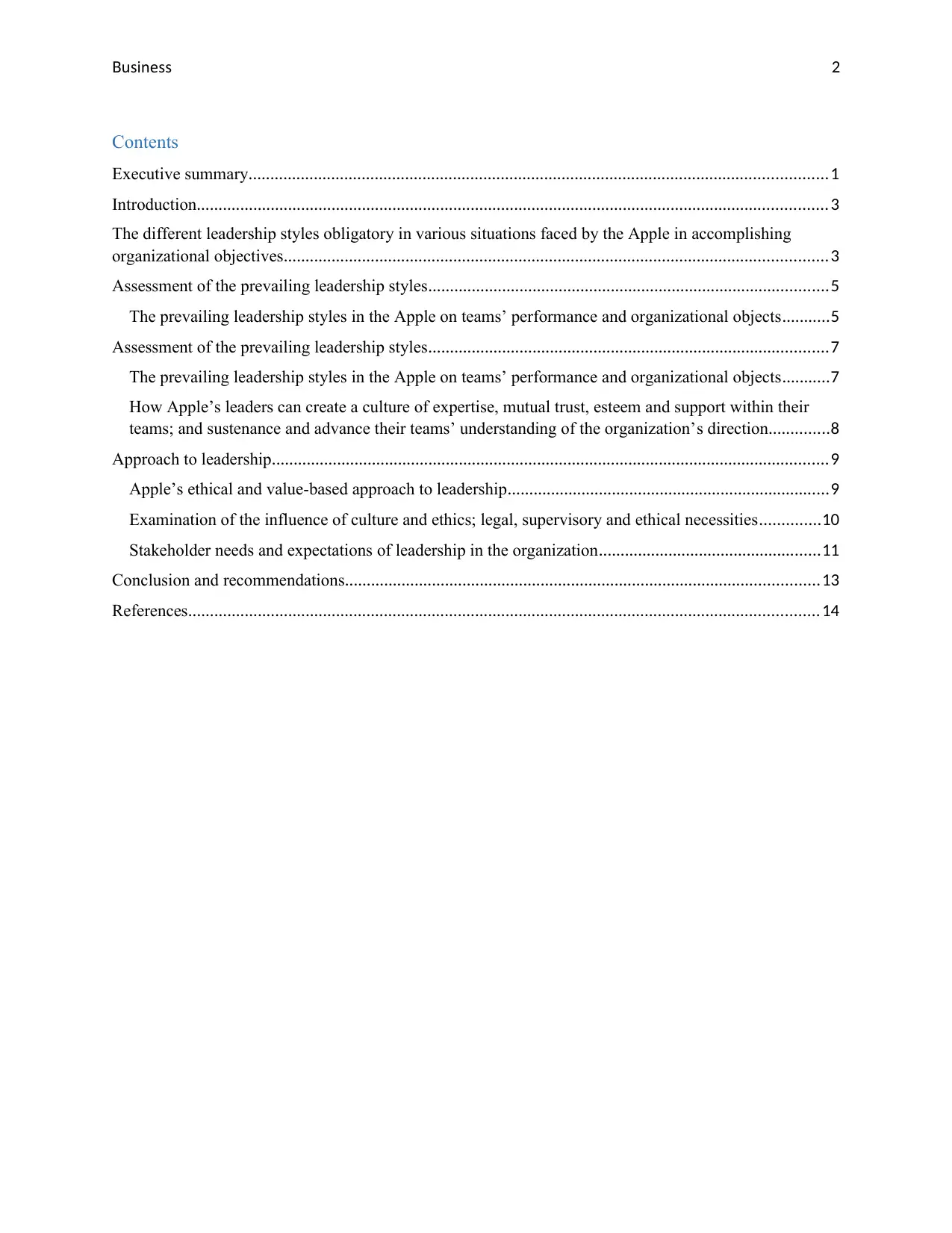
usinessB 2
Contents
Executive summary.....................................................................................................................................1
Introduction.................................................................................................................................................3
The different leadership styles obligatory in various situations faced by the Apple in accomplishing
organizational objectives.............................................................................................................................3
Assessment of the prevailing leadership styles............................................................................................5
The prevailing leadership styles in the Apple on teams’ performance and organizational objects...........5
Assessment of the prevailing leadership styles............................................................................................7
The prevailing leadership styles in the Apple on teams’ performance and organizational objects...........7
How Apple’s leaders can create a culture of expertise, mutual trust, esteem and support within their
teams; and sustenance and advance their teams’ understanding of the organization’s direction..............8
Approach to leadership................................................................................................................................9
Apple’s ethical and value-based approach to leadership..........................................................................9
Examination of the influence of culture and ethics; legal, supervisory and ethical necessities..............10
Stakeholder needs and expectations of leadership in the organization...................................................11
Conclusion and recommendations.............................................................................................................13
References.................................................................................................................................................14
Contents
Executive summary.....................................................................................................................................1
Introduction.................................................................................................................................................3
The different leadership styles obligatory in various situations faced by the Apple in accomplishing
organizational objectives.............................................................................................................................3
Assessment of the prevailing leadership styles............................................................................................5
The prevailing leadership styles in the Apple on teams’ performance and organizational objects...........5
Assessment of the prevailing leadership styles............................................................................................7
The prevailing leadership styles in the Apple on teams’ performance and organizational objects...........7
How Apple’s leaders can create a culture of expertise, mutual trust, esteem and support within their
teams; and sustenance and advance their teams’ understanding of the organization’s direction..............8
Approach to leadership................................................................................................................................9
Apple’s ethical and value-based approach to leadership..........................................................................9
Examination of the influence of culture and ethics; legal, supervisory and ethical necessities..............10
Stakeholder needs and expectations of leadership in the organization...................................................11
Conclusion and recommendations.............................................................................................................13
References.................................................................................................................................................14
⊘ This is a preview!⊘
Do you want full access?
Subscribe today to unlock all pages.

Trusted by 1+ million students worldwide
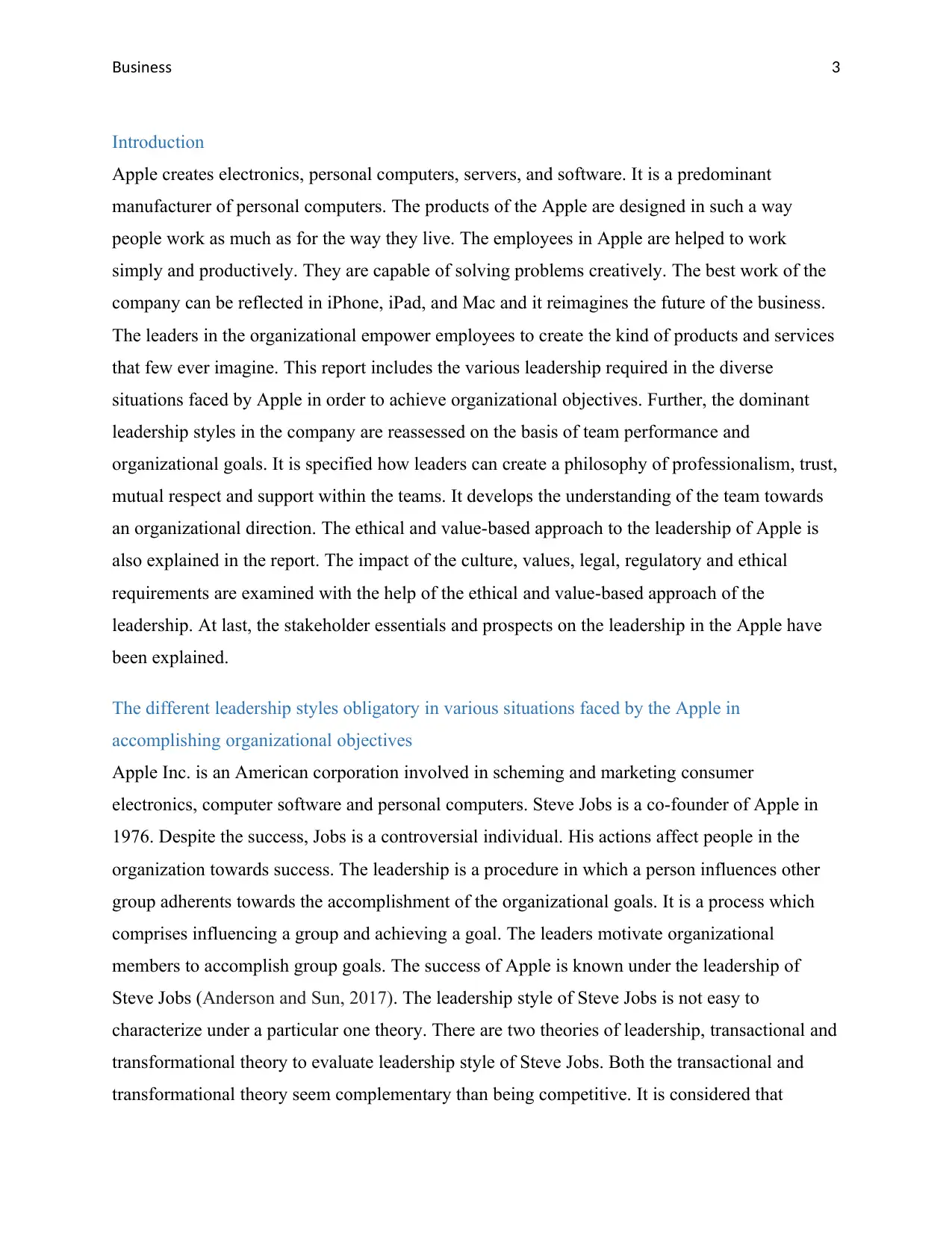
usinessB 3
Introduction
Apple creates electronics, personal computers, servers, and software. It is a predominant
manufacturer of personal computers. The products of the Apple are designed in such a way
people work as much as for the way they live. The employees in Apple are helped to work
simply and productively. They are capable of solving problems creatively. The best work of the
company can be reflected in iPhone, iPad, and Mac and it reimagines the future of the business.
The leaders in the organizational empower employees to create the kind of products and services
that few ever imagine. This report includes the various leadership required in the diverse
situations faced by Apple in order to achieve organizational objectives. Further, the dominant
leadership styles in the company are reassessed on the basis of team performance and
organizational goals. It is specified how leaders can create a philosophy of professionalism, trust,
mutual respect and support within the teams. It develops the understanding of the team towards
an organizational direction. The ethical and value-based approach to the leadership of Apple is
also explained in the report. The impact of the culture, values, legal, regulatory and ethical
requirements are examined with the help of the ethical and value-based approach of the
leadership. At last, the stakeholder essentials and prospects on the leadership in the Apple have
been explained.
The different leadership styles obligatory in various situations faced by the Apple in
accomplishing organizational objectives
Apple Inc. is an American corporation involved in scheming and marketing consumer
electronics, computer software and personal computers. Steve Jobs is a co-founder of Apple in
1976. Despite the success, Jobs is a controversial individual. His actions affect people in the
organization towards success. The leadership is a procedure in which a person influences other
group adherents towards the accomplishment of the organizational goals. It is a process which
comprises influencing a group and achieving a goal. The leaders motivate organizational
members to accomplish group goals. The success of Apple is known under the leadership of
Steve Jobs (Anderson and Sun, 2017). The leadership style of Steve Jobs is not easy to
characterize under a particular one theory. There are two theories of leadership, transactional and
transformational theory to evaluate leadership style of Steve Jobs. Both the transactional and
transformational theory seem complementary than being competitive. It is considered that
Introduction
Apple creates electronics, personal computers, servers, and software. It is a predominant
manufacturer of personal computers. The products of the Apple are designed in such a way
people work as much as for the way they live. The employees in Apple are helped to work
simply and productively. They are capable of solving problems creatively. The best work of the
company can be reflected in iPhone, iPad, and Mac and it reimagines the future of the business.
The leaders in the organizational empower employees to create the kind of products and services
that few ever imagine. This report includes the various leadership required in the diverse
situations faced by Apple in order to achieve organizational objectives. Further, the dominant
leadership styles in the company are reassessed on the basis of team performance and
organizational goals. It is specified how leaders can create a philosophy of professionalism, trust,
mutual respect and support within the teams. It develops the understanding of the team towards
an organizational direction. The ethical and value-based approach to the leadership of Apple is
also explained in the report. The impact of the culture, values, legal, regulatory and ethical
requirements are examined with the help of the ethical and value-based approach of the
leadership. At last, the stakeholder essentials and prospects on the leadership in the Apple have
been explained.
The different leadership styles obligatory in various situations faced by the Apple in
accomplishing organizational objectives
Apple Inc. is an American corporation involved in scheming and marketing consumer
electronics, computer software and personal computers. Steve Jobs is a co-founder of Apple in
1976. Despite the success, Jobs is a controversial individual. His actions affect people in the
organization towards success. The leadership is a procedure in which a person influences other
group adherents towards the accomplishment of the organizational goals. It is a process which
comprises influencing a group and achieving a goal. The leaders motivate organizational
members to accomplish group goals. The success of Apple is known under the leadership of
Steve Jobs (Anderson and Sun, 2017). The leadership style of Steve Jobs is not easy to
characterize under a particular one theory. There are two theories of leadership, transactional and
transformational theory to evaluate leadership style of Steve Jobs. Both the transactional and
transformational theory seem complementary than being competitive. It is considered that
Paraphrase This Document
Need a fresh take? Get an instant paraphrase of this document with our AI Paraphraser
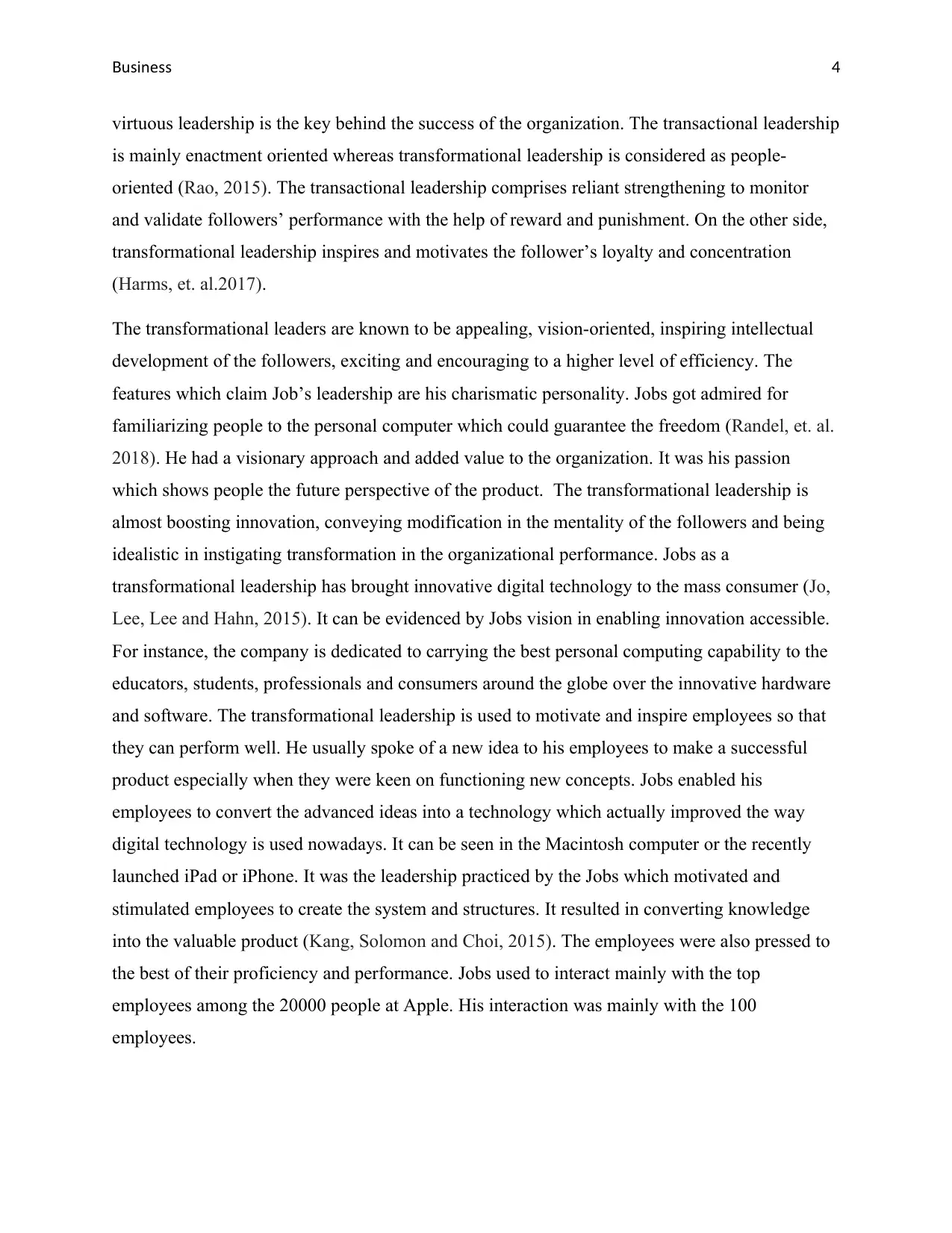
usinessB 4
virtuous leadership is the key behind the success of the organization. The transactional leadership
is mainly enactment oriented whereas transformational leadership is considered as people-
oriented (Rao, 2015). The transactional leadership comprises reliant strengthening to monitor
and validate followers’ performance with the help of reward and punishment. On the other side,
transformational leadership inspires and motivates the follower’s loyalty and concentration
(Harms, et. al.2017).
The transformational leaders are known to be appealing, vision-oriented, inspiring intellectual
development of the followers, exciting and encouraging to a higher level of efficiency. The
features which claim Job’s leadership are his charismatic personality. Jobs got admired for
familiarizing people to the personal computer which could guarantee the freedom (Randel, et. al.
2018). He had a visionary approach and added value to the organization. It was his passion
which shows people the future perspective of the product. The transformational leadership is
almost boosting innovation, conveying modification in the mentality of the followers and being
idealistic in instigating transformation in the organizational performance. Jobs as a
transformational leadership has brought innovative digital technology to the mass consumer (Jo,
Lee, Lee and Hahn, 2015). It can be evidenced by Jobs vision in enabling innovation accessible.
For instance, the company is dedicated to carrying the best personal computing capability to the
educators, students, professionals and consumers around the globe over the innovative hardware
and software. The transformational leadership is used to motivate and inspire employees so that
they can perform well. He usually spoke of a new idea to his employees to make a successful
product especially when they were keen on functioning new concepts. Jobs enabled his
employees to convert the advanced ideas into a technology which actually improved the way
digital technology is used nowadays. It can be seen in the Macintosh computer or the recently
launched iPad or iPhone. It was the leadership practiced by the Jobs which motivated and
stimulated employees to create the system and structures. It resulted in converting knowledge
into the valuable product (Kang, Solomon and Choi, 2015). The employees were also pressed to
the best of their proficiency and performance. Jobs used to interact mainly with the top
employees among the 20000 people at Apple. His interaction was mainly with the 100
employees.
virtuous leadership is the key behind the success of the organization. The transactional leadership
is mainly enactment oriented whereas transformational leadership is considered as people-
oriented (Rao, 2015). The transactional leadership comprises reliant strengthening to monitor
and validate followers’ performance with the help of reward and punishment. On the other side,
transformational leadership inspires and motivates the follower’s loyalty and concentration
(Harms, et. al.2017).
The transformational leaders are known to be appealing, vision-oriented, inspiring intellectual
development of the followers, exciting and encouraging to a higher level of efficiency. The
features which claim Job’s leadership are his charismatic personality. Jobs got admired for
familiarizing people to the personal computer which could guarantee the freedom (Randel, et. al.
2018). He had a visionary approach and added value to the organization. It was his passion
which shows people the future perspective of the product. The transformational leadership is
almost boosting innovation, conveying modification in the mentality of the followers and being
idealistic in instigating transformation in the organizational performance. Jobs as a
transformational leadership has brought innovative digital technology to the mass consumer (Jo,
Lee, Lee and Hahn, 2015). It can be evidenced by Jobs vision in enabling innovation accessible.
For instance, the company is dedicated to carrying the best personal computing capability to the
educators, students, professionals and consumers around the globe over the innovative hardware
and software. The transformational leadership is used to motivate and inspire employees so that
they can perform well. He usually spoke of a new idea to his employees to make a successful
product especially when they were keen on functioning new concepts. Jobs enabled his
employees to convert the advanced ideas into a technology which actually improved the way
digital technology is used nowadays. It can be seen in the Macintosh computer or the recently
launched iPad or iPhone. It was the leadership practiced by the Jobs which motivated and
stimulated employees to create the system and structures. It resulted in converting knowledge
into the valuable product (Kang, Solomon and Choi, 2015). The employees were also pressed to
the best of their proficiency and performance. Jobs used to interact mainly with the top
employees among the 20000 people at Apple. His interaction was mainly with the 100
employees.
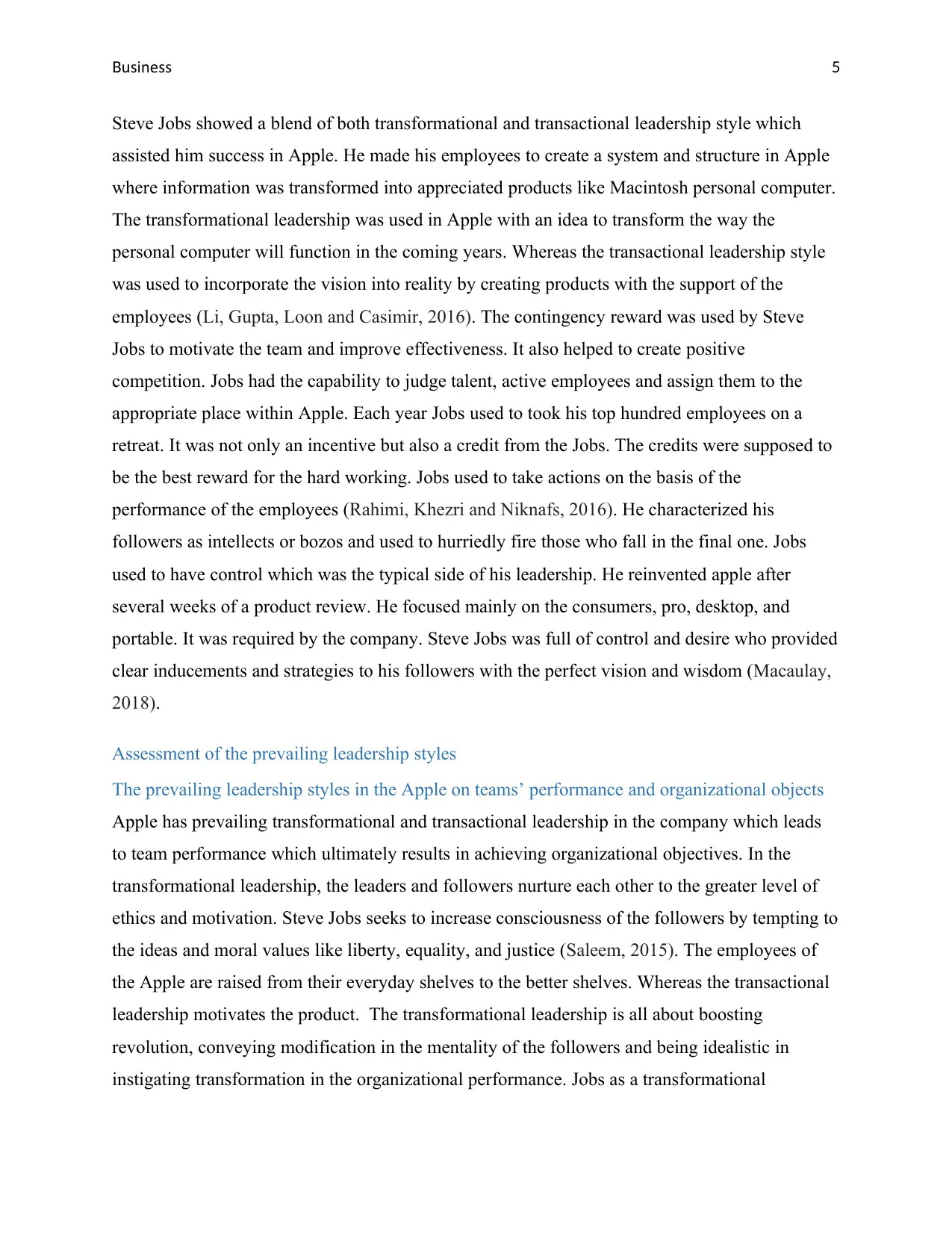
usinessB 5
Steve Jobs showed a blend of both transformational and transactional leadership style which
assisted him success in Apple. He made his employees to create a system and structure in Apple
where information was transformed into appreciated products like Macintosh personal computer.
The transformational leadership was used in Apple with an idea to transform the way the
personal computer will function in the coming years. Whereas the transactional leadership style
was used to incorporate the vision into reality by creating products with the support of the
employees (Li, Gupta, Loon and Casimir, 2016). The contingency reward was used by Steve
Jobs to motivate the team and improve effectiveness. It also helped to create positive
competition. Jobs had the capability to judge talent, active employees and assign them to the
appropriate place within Apple. Each year Jobs used to took his top hundred employees on a
retreat. It was not only an incentive but also a credit from the Jobs. The credits were supposed to
be the best reward for the hard working. Jobs used to take actions on the basis of the
performance of the employees (Rahimi, Khezri and Niknafs, 2016). He characterized his
followers as intellects or bozos and used to hurriedly fire those who fall in the final one. Jobs
used to have control which was the typical side of his leadership. He reinvented apple after
several weeks of a product review. He focused mainly on the consumers, pro, desktop, and
portable. It was required by the company. Steve Jobs was full of control and desire who provided
clear inducements and strategies to his followers with the perfect vision and wisdom (Macaulay,
2018).
Assessment of the prevailing leadership styles
The prevailing leadership styles in the Apple on teams’ performance and organizational objects
Apple has prevailing transformational and transactional leadership in the company which leads
to team performance which ultimately results in achieving organizational objectives. In the
transformational leadership, the leaders and followers nurture each other to the greater level of
ethics and motivation. Steve Jobs seeks to increase consciousness of the followers by tempting to
the ideas and moral values like liberty, equality, and justice (Saleem, 2015). The employees of
the Apple are raised from their everyday shelves to the better shelves. Whereas the transactional
leadership motivates the product. The transformational leadership is all about boosting
revolution, conveying modification in the mentality of the followers and being idealistic in
instigating transformation in the organizational performance. Jobs as a transformational
Steve Jobs showed a blend of both transformational and transactional leadership style which
assisted him success in Apple. He made his employees to create a system and structure in Apple
where information was transformed into appreciated products like Macintosh personal computer.
The transformational leadership was used in Apple with an idea to transform the way the
personal computer will function in the coming years. Whereas the transactional leadership style
was used to incorporate the vision into reality by creating products with the support of the
employees (Li, Gupta, Loon and Casimir, 2016). The contingency reward was used by Steve
Jobs to motivate the team and improve effectiveness. It also helped to create positive
competition. Jobs had the capability to judge talent, active employees and assign them to the
appropriate place within Apple. Each year Jobs used to took his top hundred employees on a
retreat. It was not only an incentive but also a credit from the Jobs. The credits were supposed to
be the best reward for the hard working. Jobs used to take actions on the basis of the
performance of the employees (Rahimi, Khezri and Niknafs, 2016). He characterized his
followers as intellects or bozos and used to hurriedly fire those who fall in the final one. Jobs
used to have control which was the typical side of his leadership. He reinvented apple after
several weeks of a product review. He focused mainly on the consumers, pro, desktop, and
portable. It was required by the company. Steve Jobs was full of control and desire who provided
clear inducements and strategies to his followers with the perfect vision and wisdom (Macaulay,
2018).
Assessment of the prevailing leadership styles
The prevailing leadership styles in the Apple on teams’ performance and organizational objects
Apple has prevailing transformational and transactional leadership in the company which leads
to team performance which ultimately results in achieving organizational objectives. In the
transformational leadership, the leaders and followers nurture each other to the greater level of
ethics and motivation. Steve Jobs seeks to increase consciousness of the followers by tempting to
the ideas and moral values like liberty, equality, and justice (Saleem, 2015). The employees of
the Apple are raised from their everyday shelves to the better shelves. Whereas the transactional
leadership motivates the product. The transformational leadership is all about boosting
revolution, conveying modification in the mentality of the followers and being idealistic in
instigating transformation in the organizational performance. Jobs as a transformational
⊘ This is a preview!⊘
Do you want full access?
Subscribe today to unlock all pages.

Trusted by 1+ million students worldwide
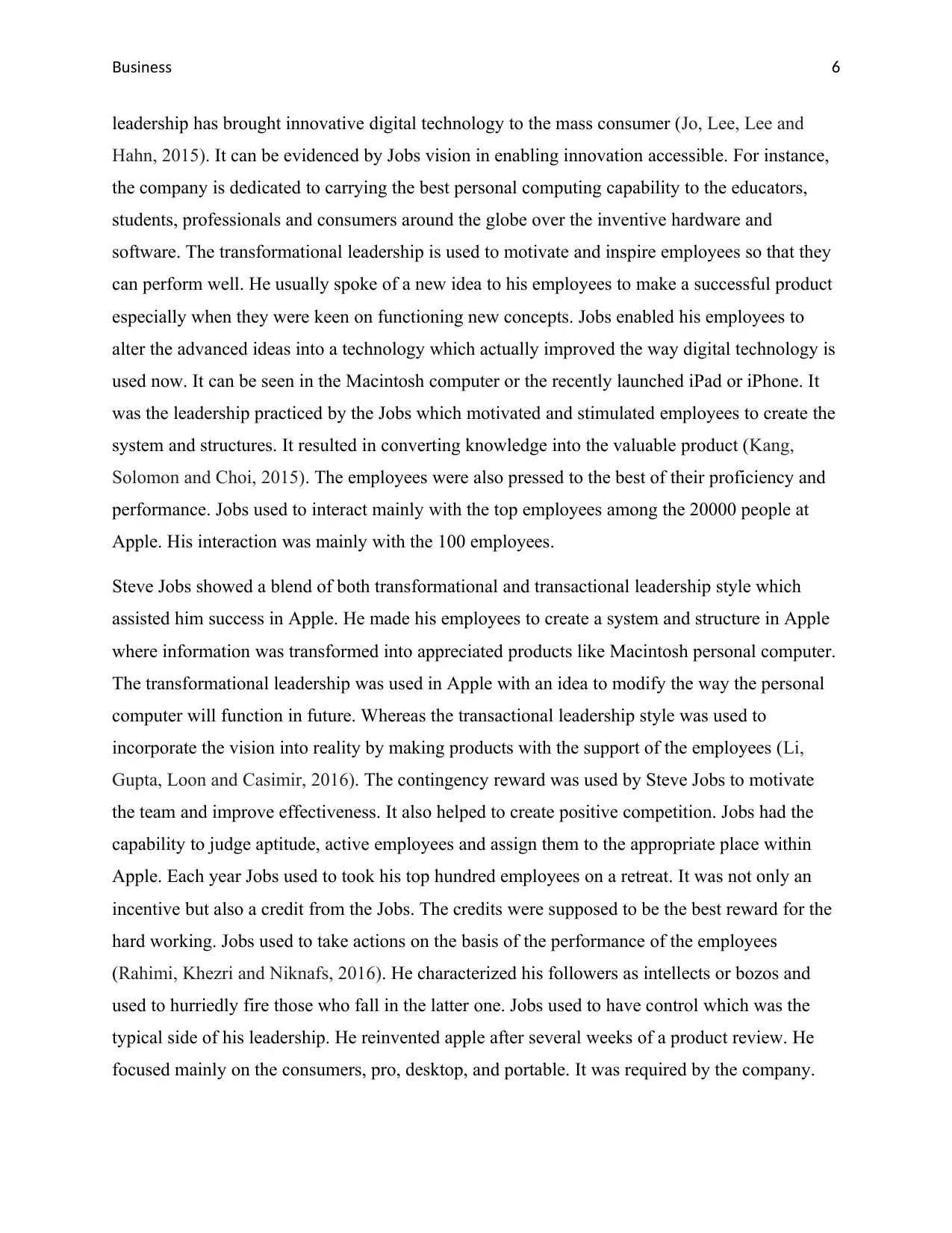
usinessB 6
leadership has brought innovative digital technology to the mass consumer (Jo, Lee, Lee and
Hahn, 2015). It can be evidenced by Jobs vision in enabling innovation accessible. For instance,
the company is dedicated to carrying the best personal computing capability to the educators,
students, professionals and consumers around the globe over the inventive hardware and
software. The transformational leadership is used to motivate and inspire employees so that they
can perform well. He usually spoke of a new idea to his employees to make a successful product
especially when they were keen on functioning new concepts. Jobs enabled his employees to
alter the advanced ideas into a technology which actually improved the way digital technology is
used now. It can be seen in the Macintosh computer or the recently launched iPad or iPhone. It
was the leadership practiced by the Jobs which motivated and stimulated employees to create the
system and structures. It resulted in converting knowledge into the valuable product (Kang,
Solomon and Choi, 2015). The employees were also pressed to the best of their proficiency and
performance. Jobs used to interact mainly with the top employees among the 20000 people at
Apple. His interaction was mainly with the 100 employees.
Steve Jobs showed a blend of both transformational and transactional leadership style which
assisted him success in Apple. He made his employees to create a system and structure in Apple
where information was transformed into appreciated products like Macintosh personal computer.
The transformational leadership was used in Apple with an idea to modify the way the personal
computer will function in future. Whereas the transactional leadership style was used to
incorporate the vision into reality by making products with the support of the employees (Li,
Gupta, Loon and Casimir, 2016). The contingency reward was used by Steve Jobs to motivate
the team and improve effectiveness. It also helped to create positive competition. Jobs had the
capability to judge aptitude, active employees and assign them to the appropriate place within
Apple. Each year Jobs used to took his top hundred employees on a retreat. It was not only an
incentive but also a credit from the Jobs. The credits were supposed to be the best reward for the
hard working. Jobs used to take actions on the basis of the performance of the employees
(Rahimi, Khezri and Niknafs, 2016). He characterized his followers as intellects or bozos and
used to hurriedly fire those who fall in the latter one. Jobs used to have control which was the
typical side of his leadership. He reinvented apple after several weeks of a product review. He
focused mainly on the consumers, pro, desktop, and portable. It was required by the company.
leadership has brought innovative digital technology to the mass consumer (Jo, Lee, Lee and
Hahn, 2015). It can be evidenced by Jobs vision in enabling innovation accessible. For instance,
the company is dedicated to carrying the best personal computing capability to the educators,
students, professionals and consumers around the globe over the inventive hardware and
software. The transformational leadership is used to motivate and inspire employees so that they
can perform well. He usually spoke of a new idea to his employees to make a successful product
especially when they were keen on functioning new concepts. Jobs enabled his employees to
alter the advanced ideas into a technology which actually improved the way digital technology is
used now. It can be seen in the Macintosh computer or the recently launched iPad or iPhone. It
was the leadership practiced by the Jobs which motivated and stimulated employees to create the
system and structures. It resulted in converting knowledge into the valuable product (Kang,
Solomon and Choi, 2015). The employees were also pressed to the best of their proficiency and
performance. Jobs used to interact mainly with the top employees among the 20000 people at
Apple. His interaction was mainly with the 100 employees.
Steve Jobs showed a blend of both transformational and transactional leadership style which
assisted him success in Apple. He made his employees to create a system and structure in Apple
where information was transformed into appreciated products like Macintosh personal computer.
The transformational leadership was used in Apple with an idea to modify the way the personal
computer will function in future. Whereas the transactional leadership style was used to
incorporate the vision into reality by making products with the support of the employees (Li,
Gupta, Loon and Casimir, 2016). The contingency reward was used by Steve Jobs to motivate
the team and improve effectiveness. It also helped to create positive competition. Jobs had the
capability to judge aptitude, active employees and assign them to the appropriate place within
Apple. Each year Jobs used to took his top hundred employees on a retreat. It was not only an
incentive but also a credit from the Jobs. The credits were supposed to be the best reward for the
hard working. Jobs used to take actions on the basis of the performance of the employees
(Rahimi, Khezri and Niknafs, 2016). He characterized his followers as intellects or bozos and
used to hurriedly fire those who fall in the latter one. Jobs used to have control which was the
typical side of his leadership. He reinvented apple after several weeks of a product review. He
focused mainly on the consumers, pro, desktop, and portable. It was required by the company.
Paraphrase This Document
Need a fresh take? Get an instant paraphrase of this document with our AI Paraphraser
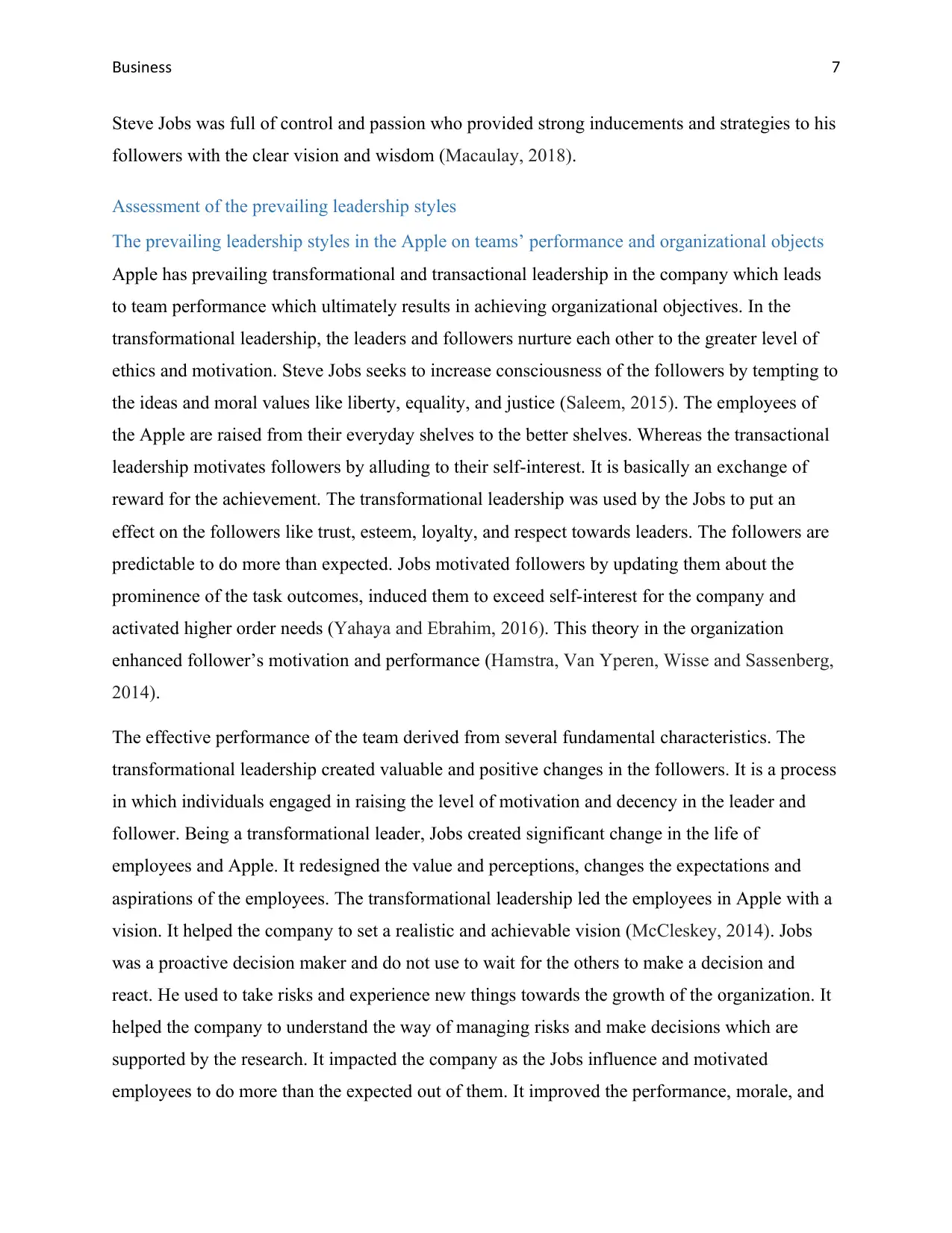
usinessB 7
Steve Jobs was full of control and passion who provided strong inducements and strategies to his
followers with the clear vision and wisdom (Macaulay, 2018).
Assessment of the prevailing leadership styles
The prevailing leadership styles in the Apple on teams’ performance and organizational objects
Apple has prevailing transformational and transactional leadership in the company which leads
to team performance which ultimately results in achieving organizational objectives. In the
transformational leadership, the leaders and followers nurture each other to the greater level of
ethics and motivation. Steve Jobs seeks to increase consciousness of the followers by tempting to
the ideas and moral values like liberty, equality, and justice (Saleem, 2015). The employees of
the Apple are raised from their everyday shelves to the better shelves. Whereas the transactional
leadership motivates followers by alluding to their self-interest. It is basically an exchange of
reward for the achievement. The transformational leadership was used by the Jobs to put an
effect on the followers like trust, esteem, loyalty, and respect towards leaders. The followers are
predictable to do more than expected. Jobs motivated followers by updating them about the
prominence of the task outcomes, induced them to exceed self-interest for the company and
activated higher order needs (Yahaya and Ebrahim, 2016). This theory in the organization
enhanced follower’s motivation and performance (Hamstra, Van Yperen, Wisse and Sassenberg,
2014).
The effective performance of the team derived from several fundamental characteristics. The
transformational leadership created valuable and positive changes in the followers. It is a process
in which individuals engaged in raising the level of motivation and decency in the leader and
follower. Being a transformational leader, Jobs created significant change in the life of
employees and Apple. It redesigned the value and perceptions, changes the expectations and
aspirations of the employees. The transformational leadership led the employees in Apple with a
vision. It helped the company to set a realistic and achievable vision (McCleskey, 2014). Jobs
was a proactive decision maker and do not use to wait for the others to make a decision and
react. He used to take risks and experience new things towards the growth of the organization. It
helped the company to understand the way of managing risks and make decisions which are
supported by the research. It impacted the company as the Jobs influence and motivated
employees to do more than the expected out of them. It improved the performance, morale, and
Steve Jobs was full of control and passion who provided strong inducements and strategies to his
followers with the clear vision and wisdom (Macaulay, 2018).
Assessment of the prevailing leadership styles
The prevailing leadership styles in the Apple on teams’ performance and organizational objects
Apple has prevailing transformational and transactional leadership in the company which leads
to team performance which ultimately results in achieving organizational objectives. In the
transformational leadership, the leaders and followers nurture each other to the greater level of
ethics and motivation. Steve Jobs seeks to increase consciousness of the followers by tempting to
the ideas and moral values like liberty, equality, and justice (Saleem, 2015). The employees of
the Apple are raised from their everyday shelves to the better shelves. Whereas the transactional
leadership motivates followers by alluding to their self-interest. It is basically an exchange of
reward for the achievement. The transformational leadership was used by the Jobs to put an
effect on the followers like trust, esteem, loyalty, and respect towards leaders. The followers are
predictable to do more than expected. Jobs motivated followers by updating them about the
prominence of the task outcomes, induced them to exceed self-interest for the company and
activated higher order needs (Yahaya and Ebrahim, 2016). This theory in the organization
enhanced follower’s motivation and performance (Hamstra, Van Yperen, Wisse and Sassenberg,
2014).
The effective performance of the team derived from several fundamental characteristics. The
transformational leadership created valuable and positive changes in the followers. It is a process
in which individuals engaged in raising the level of motivation and decency in the leader and
follower. Being a transformational leader, Jobs created significant change in the life of
employees and Apple. It redesigned the value and perceptions, changes the expectations and
aspirations of the employees. The transformational leadership led the employees in Apple with a
vision. It helped the company to set a realistic and achievable vision (McCleskey, 2014). Jobs
was a proactive decision maker and do not use to wait for the others to make a decision and
react. He used to take risks and experience new things towards the growth of the organization. It
helped the company to understand the way of managing risks and make decisions which are
supported by the research. It impacted the company as the Jobs influence and motivated
employees to do more than the expected out of them. It improved the performance, morale, and

usinessB 8
motivation of the employees in the organization. This leadership style involved multiple
stakeholders in the well-being of the organization. The transformational leadership contributed to
recognizing and supporting good ideas in the wellbeing of the organization to get new products,
services, processes, and systems. It even appreciated people in the Apple to build a strong sense
of collective identity which can carry a group even in the difficult times (Hand, Hicks, and Bahr,
2015). The transactional leadership motivated employees in Apple by punishing and rewarding
them. The completion of the tasks was assigned leads to rewards and strengthening of the
successful performance. The rewards given were both material and non-material. The material
rewards included improved job security, bonus or other rewards. Whereas nonmaterial rewards
included optimistic feedback, gratitude, and praise. The failure of performing tasks assigned as
negative feedback in the practice of dissatisfaction, displeasure, disappointment or penalizing
action. This leadership was used by the Jobs to carry out the operations of the company precisely
as recommended (Imran, Ilyas and Aslam, 2016).
How Apple’s leaders can create a culture of expertise, mutual trust, esteem and support within
their teams; and sustenance and advance their teams’ understanding of the organization’s
direction
Tim Cook who is the organizational leader of Apple can create an ethos of professionalism,
mutual trust, esteem and sustenance within the teams. He can upkeep and improve teams with
the indulgent of the organization’s track. Cook can listen to the employees in the organization.
There should be ongoing employee feedback to make them feel comfortable in sharing. The
surveys can be sent by him and can host to the focus groups. The teams can be supported by
showing them that they are being heard. The culture should be established in the organization
with a minimum discrepancy with the people around (Delegach, Kark, Katz-Navon and Van
Dijk, 2017). The values like support, respect, mutual trust and professional should be
emphasized. The leaders of the Apple are required to communicate employees within the
organization. The communication with the staff is necessary and it is an important part of the
organization. The leaders are required to instill the values in the mind of the employees in order
to strengthen the development of the culture. The teaching should be made part of the reality.
The leader can even maintain the transparent system in the organization to improve flexibility in
the organization. He can even define the culture which has a minimum discrepancy with the
people around in the organization (Iskander, Pettaway, Waller and Waller, 2016).
motivation of the employees in the organization. This leadership style involved multiple
stakeholders in the well-being of the organization. The transformational leadership contributed to
recognizing and supporting good ideas in the wellbeing of the organization to get new products,
services, processes, and systems. It even appreciated people in the Apple to build a strong sense
of collective identity which can carry a group even in the difficult times (Hand, Hicks, and Bahr,
2015). The transactional leadership motivated employees in Apple by punishing and rewarding
them. The completion of the tasks was assigned leads to rewards and strengthening of the
successful performance. The rewards given were both material and non-material. The material
rewards included improved job security, bonus or other rewards. Whereas nonmaterial rewards
included optimistic feedback, gratitude, and praise. The failure of performing tasks assigned as
negative feedback in the practice of dissatisfaction, displeasure, disappointment or penalizing
action. This leadership was used by the Jobs to carry out the operations of the company precisely
as recommended (Imran, Ilyas and Aslam, 2016).
How Apple’s leaders can create a culture of expertise, mutual trust, esteem and support within
their teams; and sustenance and advance their teams’ understanding of the organization’s
direction
Tim Cook who is the organizational leader of Apple can create an ethos of professionalism,
mutual trust, esteem and sustenance within the teams. He can upkeep and improve teams with
the indulgent of the organization’s track. Cook can listen to the employees in the organization.
There should be ongoing employee feedback to make them feel comfortable in sharing. The
surveys can be sent by him and can host to the focus groups. The teams can be supported by
showing them that they are being heard. The culture should be established in the organization
with a minimum discrepancy with the people around (Delegach, Kark, Katz-Navon and Van
Dijk, 2017). The values like support, respect, mutual trust and professional should be
emphasized. The leaders of the Apple are required to communicate employees within the
organization. The communication with the staff is necessary and it is an important part of the
organization. The leaders are required to instill the values in the mind of the employees in order
to strengthen the development of the culture. The teaching should be made part of the reality.
The leader can even maintain the transparent system in the organization to improve flexibility in
the organization. He can even define the culture which has a minimum discrepancy with the
people around in the organization (Iskander, Pettaway, Waller and Waller, 2016).
⊘ This is a preview!⊘
Do you want full access?
Subscribe today to unlock all pages.

Trusted by 1+ million students worldwide
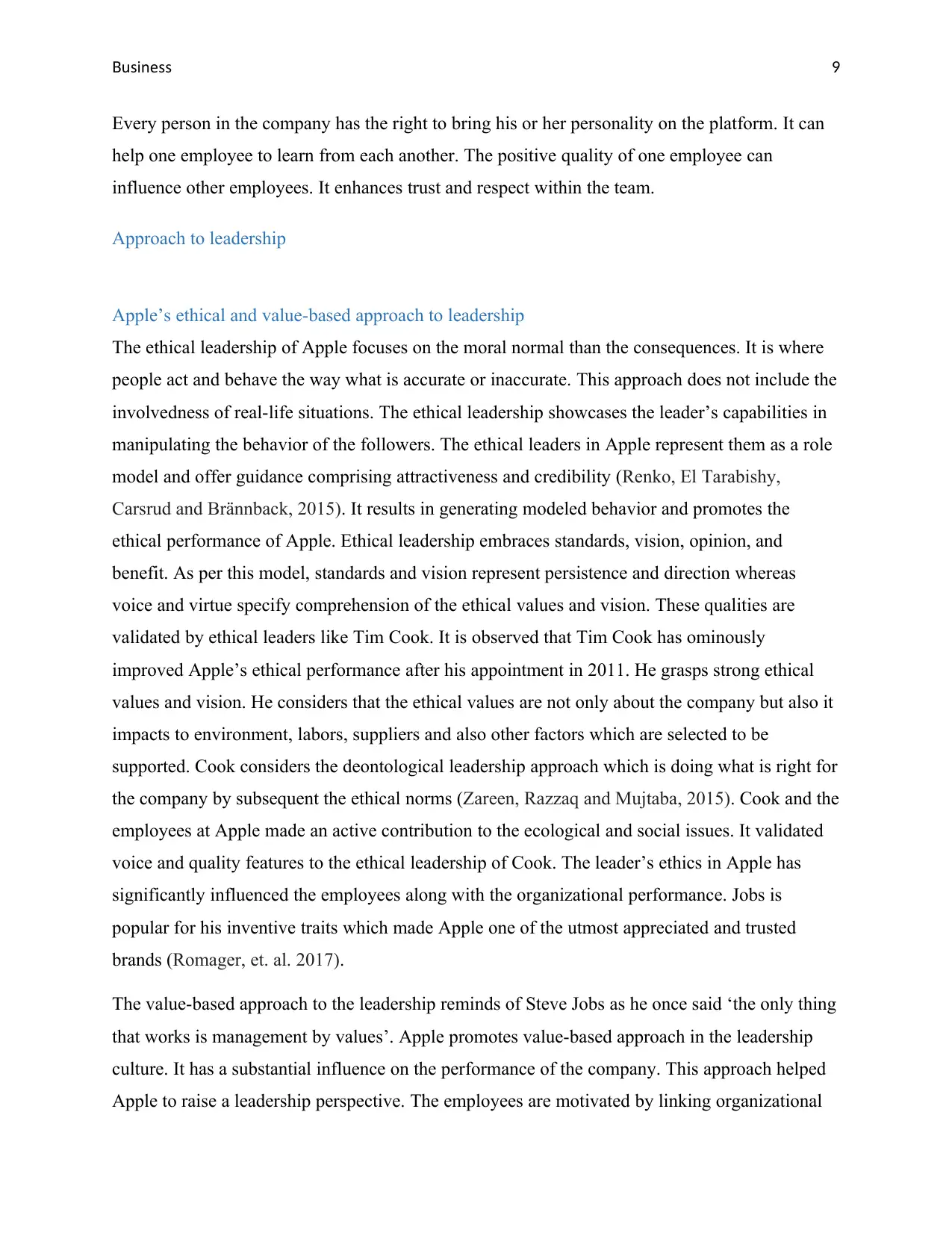
usinessB 9
Every person in the company has the right to bring his or her personality on the platform. It can
help one employee to learn from each another. The positive quality of one employee can
influence other employees. It enhances trust and respect within the team.
Approach to leadership
Apple’s ethical and value-based approach to leadership
The ethical leadership of Apple focuses on the moral normal than the consequences. It is where
people act and behave the way what is accurate or inaccurate. This approach does not include the
involvedness of real-life situations. The ethical leadership showcases the leader’s capabilities in
manipulating the behavior of the followers. The ethical leaders in Apple represent them as a role
model and offer guidance comprising attractiveness and credibility (Renko, El Tarabishy,
Carsrud and Brännback, 2015). It results in generating modeled behavior and promotes the
ethical performance of Apple. Ethical leadership embraces standards, vision, opinion, and
benefit. As per this model, standards and vision represent persistence and direction whereas
voice and virtue specify comprehension of the ethical values and vision. These qualities are
validated by ethical leaders like Tim Cook. It is observed that Tim Cook has ominously
improved Apple’s ethical performance after his appointment in 2011. He grasps strong ethical
values and vision. He considers that the ethical values are not only about the company but also it
impacts to environment, labors, suppliers and also other factors which are selected to be
supported. Cook considers the deontological leadership approach which is doing what is right for
the company by subsequent the ethical norms (Zareen, Razzaq and Mujtaba, 2015). Cook and the
employees at Apple made an active contribution to the ecological and social issues. It validated
voice and quality features to the ethical leadership of Cook. The leader’s ethics in Apple has
significantly influenced the employees along with the organizational performance. Jobs is
popular for his inventive traits which made Apple one of the utmost appreciated and trusted
brands (Romager, et. al. 2017).
The value-based approach to the leadership reminds of Steve Jobs as he once said ‘the only thing
that works is management by values’. Apple promotes value-based approach in the leadership
culture. It has a substantial influence on the performance of the company. This approach helped
Apple to raise a leadership perspective. The employees are motivated by linking organizational
Every person in the company has the right to bring his or her personality on the platform. It can
help one employee to learn from each another. The positive quality of one employee can
influence other employees. It enhances trust and respect within the team.
Approach to leadership
Apple’s ethical and value-based approach to leadership
The ethical leadership of Apple focuses on the moral normal than the consequences. It is where
people act and behave the way what is accurate or inaccurate. This approach does not include the
involvedness of real-life situations. The ethical leadership showcases the leader’s capabilities in
manipulating the behavior of the followers. The ethical leaders in Apple represent them as a role
model and offer guidance comprising attractiveness and credibility (Renko, El Tarabishy,
Carsrud and Brännback, 2015). It results in generating modeled behavior and promotes the
ethical performance of Apple. Ethical leadership embraces standards, vision, opinion, and
benefit. As per this model, standards and vision represent persistence and direction whereas
voice and virtue specify comprehension of the ethical values and vision. These qualities are
validated by ethical leaders like Tim Cook. It is observed that Tim Cook has ominously
improved Apple’s ethical performance after his appointment in 2011. He grasps strong ethical
values and vision. He considers that the ethical values are not only about the company but also it
impacts to environment, labors, suppliers and also other factors which are selected to be
supported. Cook considers the deontological leadership approach which is doing what is right for
the company by subsequent the ethical norms (Zareen, Razzaq and Mujtaba, 2015). Cook and the
employees at Apple made an active contribution to the ecological and social issues. It validated
voice and quality features to the ethical leadership of Cook. The leader’s ethics in Apple has
significantly influenced the employees along with the organizational performance. Jobs is
popular for his inventive traits which made Apple one of the utmost appreciated and trusted
brands (Romager, et. al. 2017).
The value-based approach to the leadership reminds of Steve Jobs as he once said ‘the only thing
that works is management by values’. Apple promotes value-based approach in the leadership
culture. It has a substantial influence on the performance of the company. This approach helped
Apple to raise a leadership perspective. The employees are motivated by linking organizational
Paraphrase This Document
Need a fresh take? Get an instant paraphrase of this document with our AI Paraphraser
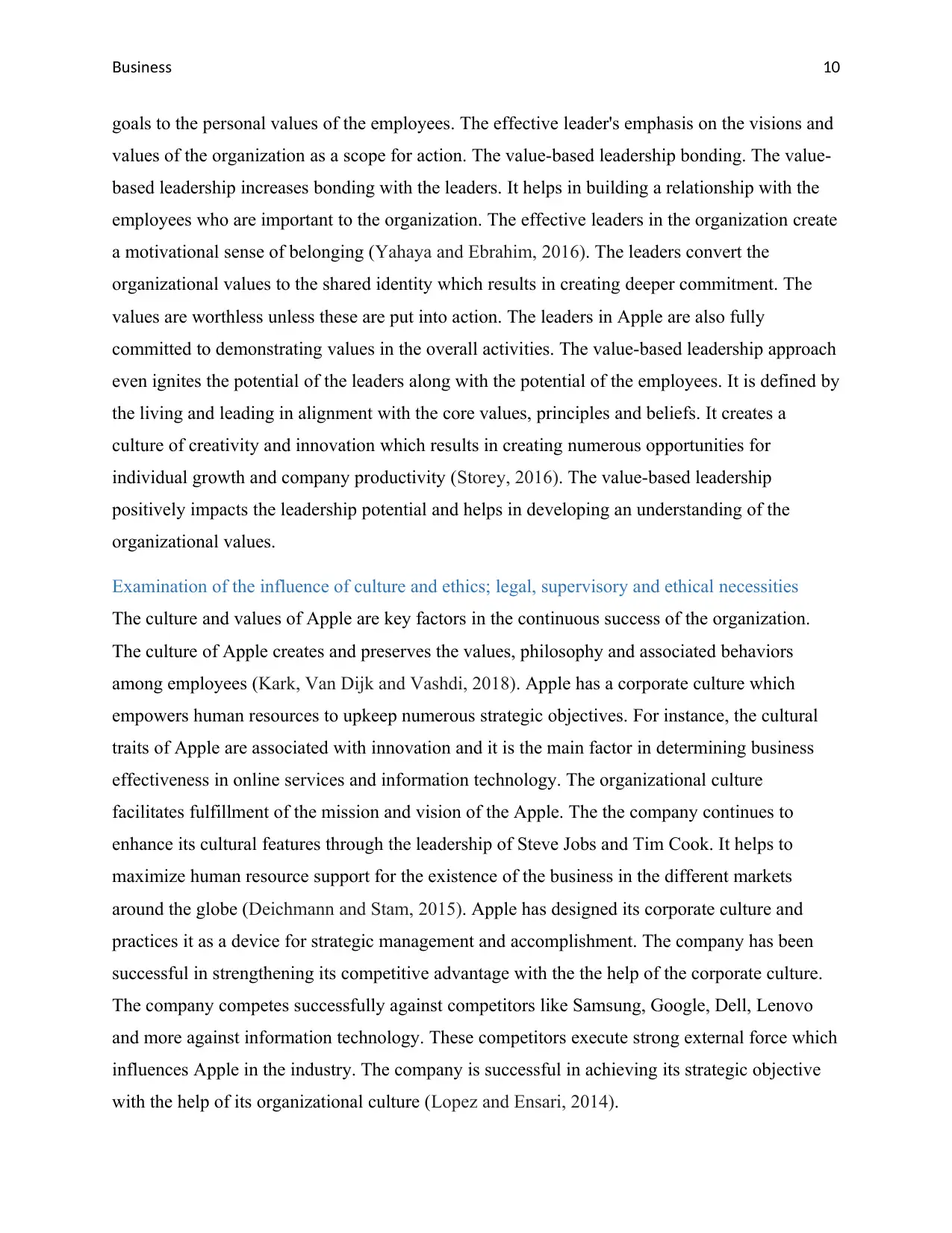
usinessB 10
goals to the personal values of the employees. The effective leader's emphasis on the visions and
values of the organization as a scope for action. The value-based leadership bonding. The value-
based leadership increases bonding with the leaders. It helps in building a relationship with the
employees who are important to the organization. The effective leaders in the organization create
a motivational sense of belonging (Yahaya and Ebrahim, 2016). The leaders convert the
organizational values to the shared identity which results in creating deeper commitment. The
values are worthless unless these are put into action. The leaders in Apple are also fully
committed to demonstrating values in the overall activities. The value-based leadership approach
even ignites the potential of the leaders along with the potential of the employees. It is defined by
the living and leading in alignment with the core values, principles and beliefs. It creates a
culture of creativity and innovation which results in creating numerous opportunities for
individual growth and company productivity (Storey, 2016). The value-based leadership
positively impacts the leadership potential and helps in developing an understanding of the
organizational values.
Examination of the influence of culture and ethics; legal, supervisory and ethical necessities
The culture and values of Apple are key factors in the continuous success of the organization.
The culture of Apple creates and preserves the values, philosophy and associated behaviors
among employees (Kark, Van Dijk and Vashdi, 2018). Apple has a corporate culture which
empowers human resources to upkeep numerous strategic objectives. For instance, the cultural
traits of Apple are associated with innovation and it is the main factor in determining business
effectiveness in online services and information technology. The organizational culture
facilitates fulfillment of the mission and vision of the Apple. The the company continues to
enhance its cultural features through the leadership of Steve Jobs and Tim Cook. It helps to
maximize human resource support for the existence of the business in the different markets
around the globe (Deichmann and Stam, 2015). Apple has designed its corporate culture and
practices it as a device for strategic management and accomplishment. The company has been
successful in strengthening its competitive advantage with the the help of the corporate culture.
The company competes successfully against competitors like Samsung, Google, Dell, Lenovo
and more against information technology. These competitors execute strong external force which
influences Apple in the industry. The company is successful in achieving its strategic objective
with the help of its organizational culture (Lopez and Ensari, 2014).
goals to the personal values of the employees. The effective leader's emphasis on the visions and
values of the organization as a scope for action. The value-based leadership bonding. The value-
based leadership increases bonding with the leaders. It helps in building a relationship with the
employees who are important to the organization. The effective leaders in the organization create
a motivational sense of belonging (Yahaya and Ebrahim, 2016). The leaders convert the
organizational values to the shared identity which results in creating deeper commitment. The
values are worthless unless these are put into action. The leaders in Apple are also fully
committed to demonstrating values in the overall activities. The value-based leadership approach
even ignites the potential of the leaders along with the potential of the employees. It is defined by
the living and leading in alignment with the core values, principles and beliefs. It creates a
culture of creativity and innovation which results in creating numerous opportunities for
individual growth and company productivity (Storey, 2016). The value-based leadership
positively impacts the leadership potential and helps in developing an understanding of the
organizational values.
Examination of the influence of culture and ethics; legal, supervisory and ethical necessities
The culture and values of Apple are key factors in the continuous success of the organization.
The culture of Apple creates and preserves the values, philosophy and associated behaviors
among employees (Kark, Van Dijk and Vashdi, 2018). Apple has a corporate culture which
empowers human resources to upkeep numerous strategic objectives. For instance, the cultural
traits of Apple are associated with innovation and it is the main factor in determining business
effectiveness in online services and information technology. The organizational culture
facilitates fulfillment of the mission and vision of the Apple. The the company continues to
enhance its cultural features through the leadership of Steve Jobs and Tim Cook. It helps to
maximize human resource support for the existence of the business in the different markets
around the globe (Deichmann and Stam, 2015). Apple has designed its corporate culture and
practices it as a device for strategic management and accomplishment. The company has been
successful in strengthening its competitive advantage with the the help of the corporate culture.
The company competes successfully against competitors like Samsung, Google, Dell, Lenovo
and more against information technology. These competitors execute strong external force which
influences Apple in the industry. The company is successful in achieving its strategic objective
with the help of its organizational culture (Lopez and Ensari, 2014).
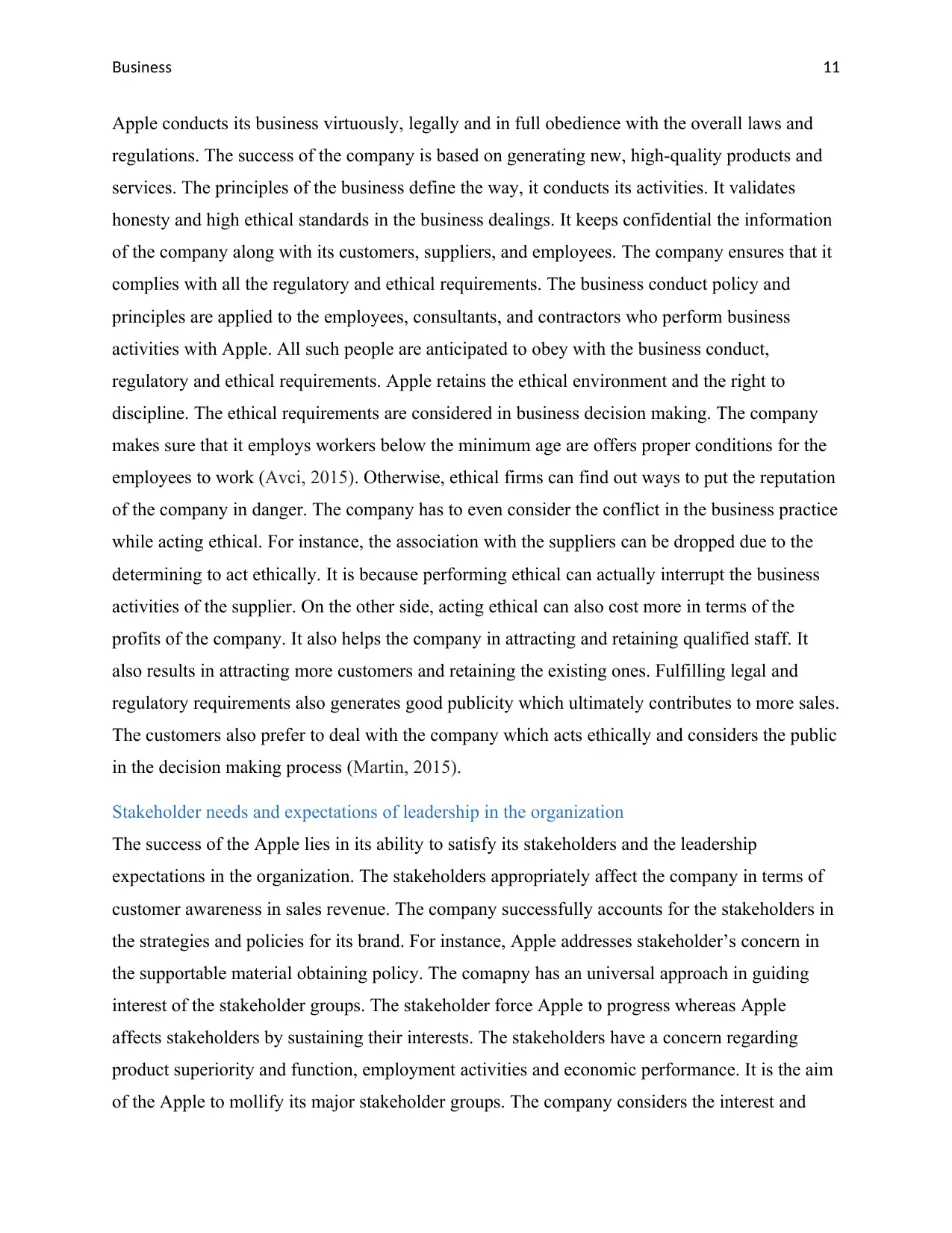
usinessB 11
Apple conducts its business virtuously, legally and in full obedience with the overall laws and
regulations. The success of the company is based on generating new, high-quality products and
services. The principles of the business define the way, it conducts its activities. It validates
honesty and high ethical standards in the business dealings. It keeps confidential the information
of the company along with its customers, suppliers, and employees. The company ensures that it
complies with all the regulatory and ethical requirements. The business conduct policy and
principles are applied to the employees, consultants, and contractors who perform business
activities with Apple. All such people are anticipated to obey with the business conduct,
regulatory and ethical requirements. Apple retains the ethical environment and the right to
discipline. The ethical requirements are considered in business decision making. The company
makes sure that it employs workers below the minimum age are offers proper conditions for the
employees to work (Avci, 2015). Otherwise, ethical firms can find out ways to put the reputation
of the company in danger. The company has to even consider the conflict in the business practice
while acting ethical. For instance, the association with the suppliers can be dropped due to the
determining to act ethically. It is because performing ethical can actually interrupt the business
activities of the supplier. On the other side, acting ethical can also cost more in terms of the
profits of the company. It also helps the company in attracting and retaining qualified staff. It
also results in attracting more customers and retaining the existing ones. Fulfilling legal and
regulatory requirements also generates good publicity which ultimately contributes to more sales.
The customers also prefer to deal with the company which acts ethically and considers the public
in the decision making process (Martin, 2015).
Stakeholder needs and expectations of leadership in the organization
The success of the Apple lies in its ability to satisfy its stakeholders and the leadership
expectations in the organization. The stakeholders appropriately affect the company in terms of
customer awareness in sales revenue. The company successfully accounts for the stakeholders in
the strategies and policies for its brand. For instance, Apple addresses stakeholder’s concern in
the supportable material obtaining policy. The comapny has an universal approach in guiding
interest of the stakeholder groups. The stakeholder force Apple to progress whereas Apple
affects stakeholders by sustaining their interests. The stakeholders have a concern regarding
product superiority and function, employment activities and economic performance. It is the aim
of the Apple to mollify its major stakeholder groups. The company considers the interest and
Apple conducts its business virtuously, legally and in full obedience with the overall laws and
regulations. The success of the company is based on generating new, high-quality products and
services. The principles of the business define the way, it conducts its activities. It validates
honesty and high ethical standards in the business dealings. It keeps confidential the information
of the company along with its customers, suppliers, and employees. The company ensures that it
complies with all the regulatory and ethical requirements. The business conduct policy and
principles are applied to the employees, consultants, and contractors who perform business
activities with Apple. All such people are anticipated to obey with the business conduct,
regulatory and ethical requirements. Apple retains the ethical environment and the right to
discipline. The ethical requirements are considered in business decision making. The company
makes sure that it employs workers below the minimum age are offers proper conditions for the
employees to work (Avci, 2015). Otherwise, ethical firms can find out ways to put the reputation
of the company in danger. The company has to even consider the conflict in the business practice
while acting ethical. For instance, the association with the suppliers can be dropped due to the
determining to act ethically. It is because performing ethical can actually interrupt the business
activities of the supplier. On the other side, acting ethical can also cost more in terms of the
profits of the company. It also helps the company in attracting and retaining qualified staff. It
also results in attracting more customers and retaining the existing ones. Fulfilling legal and
regulatory requirements also generates good publicity which ultimately contributes to more sales.
The customers also prefer to deal with the company which acts ethically and considers the public
in the decision making process (Martin, 2015).
Stakeholder needs and expectations of leadership in the organization
The success of the Apple lies in its ability to satisfy its stakeholders and the leadership
expectations in the organization. The stakeholders appropriately affect the company in terms of
customer awareness in sales revenue. The company successfully accounts for the stakeholders in
the strategies and policies for its brand. For instance, Apple addresses stakeholder’s concern in
the supportable material obtaining policy. The comapny has an universal approach in guiding
interest of the stakeholder groups. The stakeholder force Apple to progress whereas Apple
affects stakeholders by sustaining their interests. The stakeholders have a concern regarding
product superiority and function, employment activities and economic performance. It is the aim
of the Apple to mollify its major stakeholder groups. The company considers the interest and
⊘ This is a preview!⊘
Do you want full access?
Subscribe today to unlock all pages.

Trusted by 1+ million students worldwide
1 out of 18
Related Documents
Your All-in-One AI-Powered Toolkit for Academic Success.
+13062052269
info@desklib.com
Available 24*7 on WhatsApp / Email
![[object Object]](/_next/static/media/star-bottom.7253800d.svg)
Unlock your academic potential
Copyright © 2020–2025 A2Z Services. All Rights Reserved. Developed and managed by ZUCOL.





